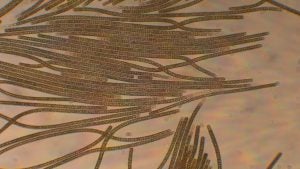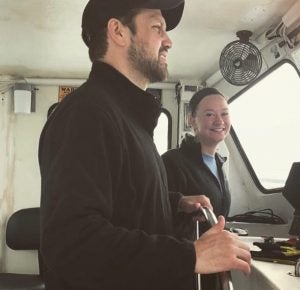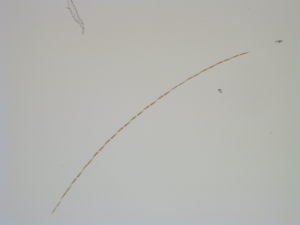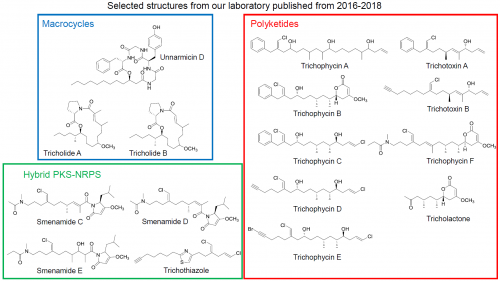Expertise: Isolation and structure characterization of marine natural products; algal toxin monitoring; secondary metabolite biosynthesis

Trichodesmium filaments (photo credit: Paul Zimba, University of Texas A&M Corpus Christi)
With a long evolutionary history and a need to adapt to dynamic environmental conditions, microbes in marine and freshwater systems use specialized metabolites for communication, defense, competition, and to maintain symbioses. However, the role that these metabolites play in differentiating species, maintaining community diversity, and generating niche persistence and expansion is poorly understood. Bloom-forming microalgal and cyanobacterial communities offer model systems for studying the role of specialized metabolites in maintaining and altering microbial communities, owing to their mixed species assemblages, prolific production of specialized metabolites, and complex microbiomes. Furthermore, the specialized metabolites produced by these organisms can be leveraged in the human health arena in therapeutic development and many of them negatively impact human health as toxins. My group’s research is at the interface between environmental health research and drug discovery. We strive to understand how marine and freshwater phytoplankton and bacteria use specialized chemicals to interact with their environment. Additionally, after my group has isolated and characterized new specialized metabolites from microbes, we determine their biological properties and effects on biological systems with the intent to place those with potent biological activity into the drug development pipeline. This research approach utilizes analytical chemistry techniques to separate complex chemical mixtures and detect, annotate, and quantify important biological molecules in microalgal systems. We use chemical biology techniques such as cytological profiling and proteomics to investigate the impact of toxins and metabolites on biological systems. My group has focused on three microbial systems during my independent research: 1) colonies of the filamentous cyanobacteria Trichodesmium sp. in the Gulf of Mexico; 2) species assemblages of the neurotoxin-producing diatom Pseudo-nitzschia in Narragansett Bay, RI; 3) freshwater cyanobacterial blooms dominated by Microcystis sp. from inland lakes in Ohio, Michigan, and Rhode Island. Additionally, we have enhanced the science surrounding the analysis of complex microbial communities using molecular methods with my collaborators at URI and elsewhere. These scientific focus areas are summarized in the figure below. We explore the chemistry of specialized metabolites by innovating in structure elucidation and chemical ecology and we investigate the biochemical mechanisms by which these specialized metabolites are created by studying the genes and enzymes in the producing organisms that generate these amazing chemical structures. My group has primarily been supported by grants from the NIH (1R21ES033758-01A1) and NOAA-RI Sea Grant (NA18OAR4170094).
We are actively recruiting a postdoc and Ph.D. students
Follow along with our group at our Instagram page (@bertbertbertlab) and bertbertbert labTwitter (@MattBertin2)
LAB NEWS
Undergraduate student Hannuo Xie was awarded first place in the 2025 Cleveland ACS Meeting in Miniature Analytical Chemistry Division Undergraduate section.
Graduate student Aaditi Chopade was awarded first place in the 2024 CWRU Chemistry Department Chemistry Research Symposium!!!
Aaditi Chopade and Runjie Xia advanced to PhD candidacy!!!
Projects
New chemistry from cyanobacterial blooms
Our research group and our collaborators have been isolating and characterizing new molecules from Trichodesmium blooms collected from the Gulf of Mexico. We have isolated diverse metabolites such as polyketides, peptides, and hybrid polyketide-peptide molecules. We have used MS/MS-based molecular networking to provide a ‘metabolite map’ to ease our isolation efforts. Currently, we are investigating the biological activity of these molecules focusing on cytotoxicity to cancer cell lines and their ability to reduce inflammation in microglia cells.
Domoic acid concentrations in Narragansett Bay
As part of our RI Sea Grant project with the Jenkins Lab at the University of Rhode Island, we are monitoring the concentrations of the neurotoxin domoic acid at select sites throughout Narragansett Bay, RI. This toxin is produced by certain diatoms of the genus Pseudo-nitzschia and can affect shellfish in the Bay and cause amnesiac shellfish poisoning in humans.


Research on Freshwater Cyanobacterial Blooms
In this NIH-funded project, we define cyanobacterial community members by isolating DNA from the blooms and using MiSeq and bioinformatics pipelines. Metabolite data is collected using an ion trap mass spectrometer and metabolites are clustered using MS/MS-based molecular networking. Following the identification of hepatotoxic components, proteomics analysis identifies potential hepatoxic mechanisms. We will also use cell imaging to define the mechanism of action of emerging toxins such as the cyanobufalins. These toxins can also be pursued for potential therapeutic leads and chemical biology tools. Lake Erie is an important site for this avenue of research.
Latest Journal Article: If you want to get a sense of what we do in the lab, check out our latest journal article in ACS Chemical Biology.
- Chopade, A.; Kim, A. M.; Berthold, D. E.; Lefler, F. W.; Laughinghouse IV, H. D.; Bertin, M. J.* Characterization of the tychonamide biosynthetic pathway in the recently described cyanobacterial species Floridanema aerugineum. 2025, doi: 10.1021/acschembio.5c00504. PMID: 41151058.
- Jouaneh, T. M. M.; Morison, J. J.; Luthern, A. C.; Kirk, R. D.; Camberg, J. L.; Bertin, M. J.* Catechol-containing polyphenols and phenolic acids reverse uropathogenic Escherichia coli quiescence in multiple strains. Nutraceuticals 2025, 5, 29. doi: 10.3390/nutraceuticals5040029.
- Kim, A. M.; Xia, R.; Bertin, M. J.* Synthesis and modeling of natural product-inspired cyclic peptides. Prod. Res. 2025, doi: 10.1080/14786419.2025.2569803.
- Xia, R.; Xie, H.; Mahmud, A. M. S.; Bertin, M. J.* Alteration in amino acid composition and configuration in cyanobacterial peptides affects biological activity. Nat. Prod. 2025, 88 (8), 1950-1957. https://doi.org/10.1021/acs.jnatprod.5c00619. PMCID: PMC12418302.
- Chen, S.; Al Kinani, S.; Horyn, O.; Galliano, C.; Srivastava, E.; Rowley, D. C.; Ramsey, K. M.; Mathur, D. Bertin, M. J.* Specialization of sesquiterpene lactone metabolites in Liriodendron plant defense. Nat. Prod. 2025, 88(7), 1811-1818. doi: 10.1021/acs.jnatprod.5c00620. PMCID: PMC12369000.
- Jarmusch, A. K.; Aron, A. T.; Petras, D.; Phelan, V. V.; Bittremieux, W.; Acharya, D. D.; Ahmed, M. M. A.; Bauermeister, A.; Bertin, M. J.; Boudreau, P. D.; Borges, R. M.; Bowen, B. P.; Brown, C. J.; Chagas, F. O.; Clevenger, K. D.; Correia, M. S. P.; Crandall, W. J.; Crüsemann, M.; Damiani, T.; Fiehn, O.; Garg, N.; Gerwick, W. H.; Gilbert, J. R.; Globisch, D.; Gomes, P. W. P.; Heuckeroth, S.; James, C. A.; Jarmusch, S. A.; Kakhkhorov, S. A.; Kang, K. B.; Kersten, R. D.; Kim, H.; Kirk, R. D.; Kohlbacher, O.; Kontou, E. E.; Liu, K.; Lizama-Chamu, I.; Luu, G. T.; Knaan, T. L.; Marty, M. T.; McAvoy, A. C.; McCall, L.-I.; Mohamed, O. G.; Nahor, O.; Niedermeyer, T. H. J.; Northen, T. R.; Overdahl, K. E.; Pluskal, T.; Rainer, J.; Reher, R.; Rodriguez, E.; Sachsenberg, T. T.; Sanchez, L. M.; Schmid, R.; Stevens, C.; Tian, Z.; Tripathi, A.; Tsugawa, H.; Nishida, K.; Matsuzawa, Y.; van der Hooft, J. J. J.; Vicini, A.; Walter, A.; Weber, T.; Xiong, Q.; Xu, T.; Zhao, H. N.; Dorrestein, P. C.; Wang, M. A Universal language for finding mass spectrometry data patterns. Methods 2025, 22(6), 1247-1254. doi: 10.1038/s41592-025-02660-z. PMCID: PMC12334354.
- Roche, K. M.; Church, I. N.; Sterling, A. R.; Rynearson, T. A.; Kim, A. M.; Bertin, M. J.; Jenkins, B. D. Connectivity of toxigenic Pseudo-nitzschia species assemblages between the Northeast U.S. continental shelf and an adjacent estuary. Harmful Algae 2024, 139, 102738. https://doi.org/10.1016/j.hal.2024.102738.
- Maurer, J. A.; Xia, R.; Kim, A. M.; Oblie, N.; Hefferan, S.; Xie, H.; Slitt, A.; Jenkins, B. D.; Bertin, M. J.* Temporal dynamics of cyanobacterial bloom community composition and toxin production from urban lakes. ACS ES&T Water 2024, 4(8), 3423-3432. https://doi.org/10.1021/acsestwater.4c00266.
- Avalon, N. E.; Reis, M. A.; Thornburg, C. C.; Williamson, R. T.; Bertin, M. J.; Aron, A. T.; Petras, D.; Mitrevska, J.; Ferreira, L.; Alexander, K. L.; Vulpanovici, F. A.; Whitner, S.; Choi, H.; Vasconcelos, V.; Spengler, G.; Blinov, K.; Kew, W. R.; Pasa-Tolic, L.; Dorrestein, P. C.; Gerwick, L.; McPhail, K. L.; Gerwick, W. H. Leptochelins A-C, cytotoxic metallophores produced by geographically dispersed Lepthoe strains of marine cyanobacteria. Am. Chem. Soc 2024, 146(27), 18626-18638. https://doi.org/10.1021/jacs.4c05399.
- Via, C. W.; Grauso, L.; McManus, K. M.; Kirk, R. D.; Kim, A. M.; Webb, E. A.; Held, N. A.; Saito, M. A.; Scarpato, S.; Zimba, P. V.; Moeller. P. D. R.; Mangoni, A.; Bertin, M. J.* Spatial and temporal resolution of cyanobacterial bloom chemistry reveals an open-ocean Trichodesmium thiebautii as a talented producer of specialized metabolites. Sci. Technol. 2024, in press, 10.1021/acs.est.3c10739.
- Kelly, K. J.; Mansour, A.; Liang, C.; Kim, A. M.; Mancini, L.; Bertin, M. J.; Jenkins, B. D.; Hutchins, D. A.; Fu, F. -X. Simulated upwelling and marine heatwave events promote similar growth rates but differential domoic acid toxicity in Pseudo-nitzschia australis. Harmful Algae 2023, 127, 102467. doi: 10.1016/j.hal.2023.102467.
- Hemme, C. L.; Carley, R.; Norton, A.; Ghumman, M.; Nguyen, H.; Ivone, R.; Menon, J. U.; Shen, J.; Bertin, M. J.; King, R.; Leibovitz, E.; Bergstrom, R.; Cho, B. Developing virtual and augmented reality applications for science, technology, engineering and math education. BioTechniques 2023, doi: 10.2144/btn-2023-0029.
- Torrey, J.; Liu, Y.; Li, H.; Ma, H.; Via, C. W.; Bertin, M. J.; Seeram, N. P. What is authentic maple water? A twelve-month shelf-life study of the chemical composition of maple water and its biological activities. Foods 2023, 12, 239. doi: 10.3390/foods12020239.
- Kirk, R. D.; Rosario, M. E.; Oblie, N.; Jouaneh, T. M. M.; Carro, M. A.; Wu, C.; Kim, A. M.; Leibovitz, ; Hunter, E. S.; Literman, R.; Handy, S. M.; Rowley, D. C.; Bertin M. J.* Screening the PRISM library against Staphylococcus aureus reveals a sesquiterpene lactone from Liriodendron tulipifera with inhibitory activity. ACS Omega 2022, 7, 35677-35685. doi: 10.1021/acsomega.2c03539. PMCID: PMC9558601.
- Kirk, R. D.; Akanji, T.; Li, H.; Shen, J.; Allababidi, S.; Seeram, N. P.; Bertin, M. J.*; Ma, H.* Evaluations of skin permeability of cannabidiol and its topical formulations by skin membrane based parallel artificial membrane permeability assay and Franz cell diffusion assay. Cannabis Cannabinoids 2022, 5, 129-137. doi: 10.1159/000526769.
- Jouaneh, M. M.; Rosario, M. E.; Li, Y.; Leibovitz, E.; Bertin, M. J.* Incorporating LC-MS/MS analysis and dereplication of natural product samples into an upper-division undergraduate laboratory course. J. Chem. Educ. 2022, 99, 2636-2642. doi: 10.1021/acs.jchemed.1c01212.
- Roche, M.; Sterling, A. R.; Rynearson, T. A.; Bertin, M. J.; Jenkins, B. D. A decade of time series sampling reveals thermal variation and shifts in Pseudo-nitzschia species composition that contribute to harmful algal bloom in an Eastern estuary. Front. Mar. Sci. 2022, 9, doi: 10.3389/fmars.2022.889840.
- Sterling, A. R.; Kirk, R. D.; Bertin, M. J.; Rynearson, T. A.; Borkman, D. G.; Caponi, M. C.; Carney, ; Hubbard, K. A.; King, M. A.; Maranda, L.; McDermith, E. J.; Santos, N. R.; Strock, J. P.; Tully, E. M.; Vaverka, S. B.; Wilson, P. D.; Jenkins, B. D. Emerging harmful algal blooms caused by distinct seasonal assemblages of a toxic diatom. Limnol. Oceanogr. 2022, 67, 2341-2359. doi: 10.1002/lno.12189.
- Jouaneh, M. M.; Motta, N.; Wu, C.; Coffey, C.; Via, C. W.; Kirk, R. D.; Bertin, M. J.* Analysis of botanicals and botanical supplements by LC-MS/MS-based molecular networking: approaches for annotating plant metabolites and authentication. Fitoterapia 2022, 159, 105200. doi: 10.1016/j.fitote.2022.105200.
- McDermith, J.; Sterling, A. R.; Bertin, M. J. Jenkins, B. D. Draft genome of Salegentibacter sp. strain BDJ18, a plankton-associated bacterium in the northeast Atlantic Ocean. Microbiol. Resour. Announc. 2021, 10:e00628-21. doi: 10.1128/MRA.00628-21. (genome announcement).
- Kirk, R. D.; He, H.; Wahome, P. G.; Wu, S.; Carter, G. T.; Bertin, M. J.* New micropeptins with anti-neuroinflammatory activity isolated from a cyanobacterial bloom. ACS Omega 2021, 6, 15472-15478. doi: 10.1021/acsomega.1c02025.
- Kirk, R. D.; Picard, K.; Christian, J. A.; Johnson, S. L.; DeBoef, B.; Bertin, M. J.* Unnarmicin D, an anti-inflammatory cyanobacterial metabolite with delta and mu opioid binding activity discovered via a pipeline approach designed to target neurotherapeutics. ACS Chem. Neurosci. 2020, 11, 4478-4488. doi: 10.1021/acschemneuro.0c00686. PMCID: PMC7811748.
- Kirk, R. D.; Carro, M. A.; Wu, C.; Aldine, M. J.; Wharton, A. M.; Goldstein, D. G.; Rosario, M. E.; Gallucci, G. M. Zhao, Y.; Leibovitz, E.; Bertin, M. J.* Integrating natural product chemistry workflows into medicinal chemistry laboratory training: building the PRISM library and cultivating independent research. Chem. Ed. 2020, 98, 410-415. doi: 10.1021/acs.jchemed.0c00396.
- Liu, C.; Xu, Y.; Kirk, R. D.; Bertin, M. J.; Seeram, N. P.; Ma, H. Inhibitory effects of skin permeable glucitol-core containing gallotannins from red maple leaves on elastase and their protective effects on human keratinocytes. Funct. Foods 2020, 75, 104208. doi: 10.1016/j.jff.2020.104208.
- McManus, K. M.; Kirk, R. D.; Via, C. W. Lotti, J. S.; Roduit, A. F.; Teta, R.; Scarpato, S.; Mangoni, A.; Bertin, M. J.* Isolation of isotrichophycin C and trichophycins G-I from a collection of Trichodesmium thiebautii. Nat. Prod. 2020, 83, 2664-2671. doi: 10.1021/acs.jnatprod.0c00550. PMCID: PMC7815318.
- Ndukwe, I. E.; Wang, X.; Lam, N. Y. S.; Ermanis, K.; Alexander, K. L.; Bertin, M. J.; Martin, G. E.; Muir, G.; Paterson, I.; Britton, R.; Goodman, J. M.; Helfrich, E. J. N.; Piel, J.; Gerwick, W. H.; Williamson, R. T. Synergism of anisotropic and computational NMR methods reveals the likely configuration of phormidolide A. Commun. 2020, 56, 7565-7568. doi: 10.1039/D0CC03055D. PMCID: PMC7436192.
- Johnson, S. L.; Kirk, R. D.; DaSilva, N. A.; Ma, H.; Seeram, N. P.; Bertin, M.J.* Polyphenol microbial metabolites exhibit gut and blood-brain barrier permeability and protect murine microglia against LPS-induced inflammation. Metabolites 2019, 9, 78. doi: 10.3390/metabo9040078. PMCID: PMC6523162.
- Teta, R.; Della Salla, G.; Esposito, G.; Via, C. W.; Mazzoccoli, C.; Piccoli, C.; Bertin, M. J.; Costantino, V.; Mangoni, A. A joint molecular networking study of a Smenospongia sponge and a cyanobacterial bloom revealed new antiproliferative chlorinated polyketides. Chem. Front. 2019, 6, 1762-1774. doi: 10.1039/C9QO00074G. PMCID: PMC6927677.
- He, H.; Bertin, M. J.; Wu, S.; Wahome, P.; Beauchesne, K. R.; Youngs, R.; Zimba, P. V.; Moeller, P. D. R.; Sauri, J.; Carter, G. T. Cyanobufalins: cardioactive toxins from cyanobacterial blooms. Nat. Prod. 2018, 81, 2576-2581. doi: 10.1021/acs.jnatprod.8b00736.
- Bertin, M. J.;* Sauri, J.; Liu, Y.; Via, C. W.; Roduit, A. F.; Williamson, R. T. Trichophycins B-F, chlorovinylidene-containing polyketides isolated from a cyanobacterial bloom. Org. Chem. 2018, 83, 13256-13266. doi: 10.1021/acs.joc.8b02070. PMCID: PMC7085936.
- Via, C. W.; Glukhov, E.; Costa, S.; Zimba, P. V.; Moeller, P. D. R.; Gerwick, W. H.; Bertin, J.* The metabolome of a cyanobacterial bloom visualized by MS/MS-based molecular networking reveals new neurotoxic smenamide analogs (C, D, and E). Front. Chem. 2018, 6, 316. doi: 10.3389/fchem.2018.00316. PMCID: PMC6071517.
- He, H.; Wahome, P. G.; Bertin, J.; Pedone, A. C.; Beauchesne, K. R.; Moeller, P. D. R.; Carter, G. T. Microcystins containing doubly homologated tyrosine residues from a Microcystis aeruginosa bloom: structures and cytotoxicity. J. Nat. Prod. 2018, 81, 1368-1375. doi: 10.1021/acs.jnatprod.7b00986.
- Belisle, R. S.; Via, C. W.; Schock, T. B.; Villareal, T. A.; Zimba, P. V.; Beauchesne, K. R.; Moeller, P. D. R.; Bertin, M. J.* Trichothiazole A, a dichlorinated polyketide containing an embedded thiazole isolated from Trichodesmium Tetrahedron Lett. 2017, 58, 4066-4068. doi: 10.1016/j.tetlet.2017.09.027. PMCID: PMC7079771.
- Bertin, M. J.;* Roduit, A. F.; Sun, J.; Alves, G.; Via, C. W.; Gonzalez, M. A.; Zimba, P. V.; Moeller, P. D. R. Tricholides A and B and unnarmicin D: new hybrid PKS-NRPS macrocycles isolated from an environmental collection of Trichodesmium thiebautii. Drugs 2017, 15, doi: 10.3390/md15070206. PMCID: PMC5532648.
- Pye, C. R.; Bertin, M. J.; Lokey, R. S.; Gerwick, W. H.; Linington, R. G. Retrospective analysis of natural products provides insights for future discovery trends. Natl. Acad. Sci. U. S. A. 2017, 114, 5601-5606. doi: 10.1073/pnas.1614680114. PMCID: PMC5465889.
- Bertin, M. J.;* Wahome, P. G.; Zimba, P. V.; He, H.; Moeller, P. D. R. Trichophycin A, a cytotoxic linear polyketide isolated from a Trichodesmium thiebautii Mar. Drugs 2017, 15, doi:10.3390/md15010010. PMCID: PMC5295230.
- Bertin, M. J.;* Zimba, P. V.; He, H.; Moeller, P. D. R. Structure revision of trichotoxin, a chlorinated polyketide isolated from a Trichodesmium thiebautii Tetrahedron Lett. 2016, 57, 5864-5867. doi: 10.1016/j.tetlet.2016.11.062. PMCID: PMC7062361.
*corresponding author
Dr. Matthew Bertin – Dr. Bertin began his appointment at Case Western University in July of 2023. Before that he was a faculty member at the University of Rhode Island. He completed his Ph.D. at the Medical University of South Carolina under the guidance of Peter Moeller. He completed his postdoctoral training under the supervision of William H. Gerwick at the Scripps Institution of Oceanography. When he’s not looking at mass spec and NMR data, Dr. Bertin enjoys hiking and reading science fiction.
Runjie Xia – Runjie is a 2nd-year PhD student in the Department of Chemistry. She earned her B.Eng. degree in Materials Chemistry from University of Anhui Normal University, China. Her research focuses on the study of CyanoHABs, she will isolate and characterize these new toxins and explore their liver toxicity. Outside the lab, she enjoys traveling, cooking and doing crafts.
Shiwei Chen – Shiewi is a 1st-year PhD student in the Department of Chemistry at Case Western Reserve University. She earned her B.A degree in Chemistry from The Ohio State University. Her research focuses on the study of antimicrobial properties of metabolites from plants. Outside of lab, she loves traveling and movies.
Aaditi Chopade – Aaditi is a 2nd-year PhD student in the Department of Chemistry. She earned her B.A. in Chemistry at Mount Holyoke College. Her research focuses on the specialized metabolites produced by the open-ocean cyanobacterial genus Trichodesmium. Outside of the lab, she enjoys trying different tea blends, reading, and spending time with her cat Mogra.
Michaela Burkhauser – Michaela is a 1st-year PhD student in the Department of Chemistry. She earned her B.S. in Chemistry at Youngstown State University. Her research focuses on the specialized metabolites produced by freshwater cyanobacterial blooms and their chemical biology.
Matthew Bertin
Gilles and Malvina Klopman Assistant Professor of Chemistry
Contact
mxb1224@case.edu
216.368.0602
Clapp Hall 212B
Other Information
Degree: PhD, The Medical University of South Carolina
Research Interests
Medicinal chemistry, organic chemistry, natural products, chemical ecology, analytical chemistry, mass spectrometry
Education
- Postdoctoral Researcher at the Scripps Institution of Oceanography, University of California San Diego, La Jolla CA
- PhD in Biomedical Science at The Medical University of South Carolina (2012)
- MS in Biological Sciences at Florida State University (2006)
- BA in Zoology at Miami University (2003)










